Key takeaways:
- Vintage toys and games evoke strong emotions, reflecting cultural values and personal memories.
- Restoration of old games not only preserves nostalgia but also fosters connections and creates new memories.
- Assessing a game’s condition is crucial, with attention to individual components and the box’s history.
- Reviving game components requires cleaning, reinforcing fragile pieces, and sometimes creating new parts, enhancing personal connections to the games.

Understanding vintage toys
Vintage toys hold not only nostalgic value but also a glimpse into the cultural zeitgeist of their time. I remember unearthing a dusty box of my childhood toys from the attic; the moment I touched those well-loved cars and dolls, it was like stepping back into my happiest memories. How can a simple toy evoke such strong emotions and connections to the past?
Understanding vintage toys is about recognizing the stories they tell. Each piece reflects the materials, design philosophies, and societal norms of its era. I once found a 1970s Game of Life at a thrift store. As I explained the game to a friend, I realized how it encapsulated the aspirations and values of its time, sparking a conversation about how much our priorities have shifted since then. Have you ever wondered what your favorite childhood toy says about you?
These toys aren’t just relics; they’re treasures that reveal the evolution of play and creativity. I often think about how my old board games have the power to bring families together. In a world dominated by screens, don’t you feel a sense of joy in rediscovering the simplicity and connection that comes with gathering around a table for a game night? Vintage toys remind us that play is essential, and their history is part of our collective experience.
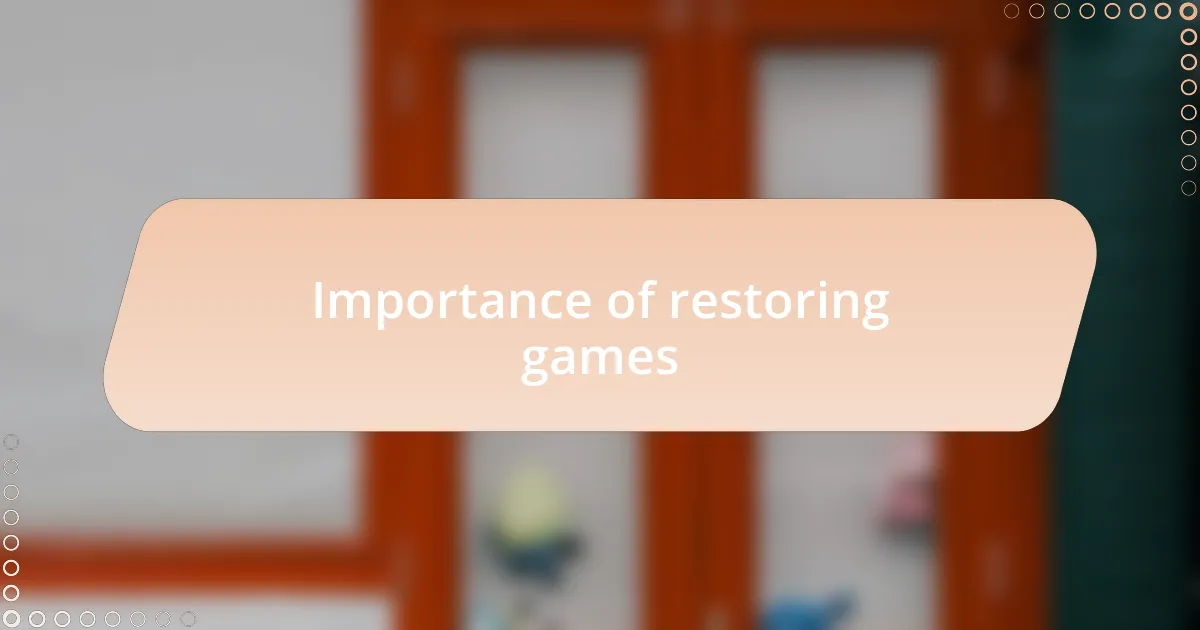
Importance of restoring games
Restoring old board games is crucial for preserving not just the game itself but the memories and traditions associated with it. I vividly remember the joy I felt when I refurbished my grandmother’s Monopoly set. The pieces weren’t just plastic tokens; they held countless family game nights that bonded us. How many cherished stories could we lose if we neglect these items?
Beyond preservation, restoring games can reignite the spirit of fellowship and laughter they once fostered. I recall the thrill of dusting off a tattered Scrabble board and inviting friends over for a game. The familiar clatter of tiles brought back a wave of nostalgia, reminding us all that simple pleasures can still forge powerful connections. Isn’t it amazing how an old game can reignite friendships and foster new memories?
Moreover, the process of restoration itself can be an enriching experience. Once, while painting over faded pieces in a Jenga set, I found myself reflecting on the countless times I played it during my college years. Each brush stroke felt like a way to reclaim that playful spirit. Isn’t engaging in the very act of restoration a way to appreciate and honor their past?
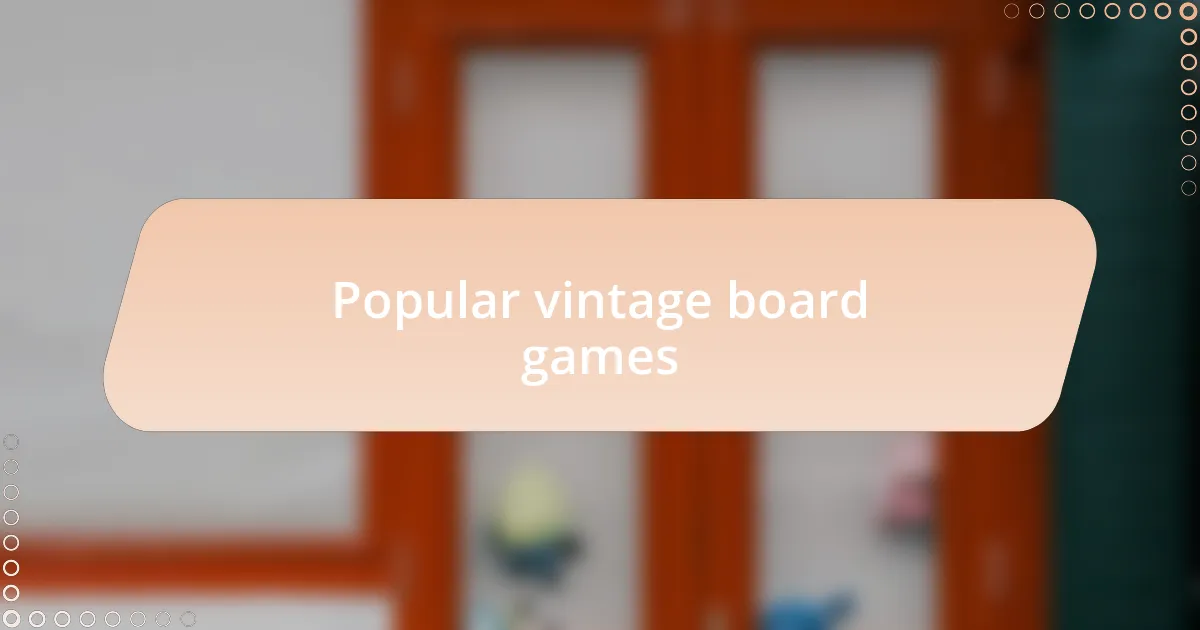
Popular vintage board games
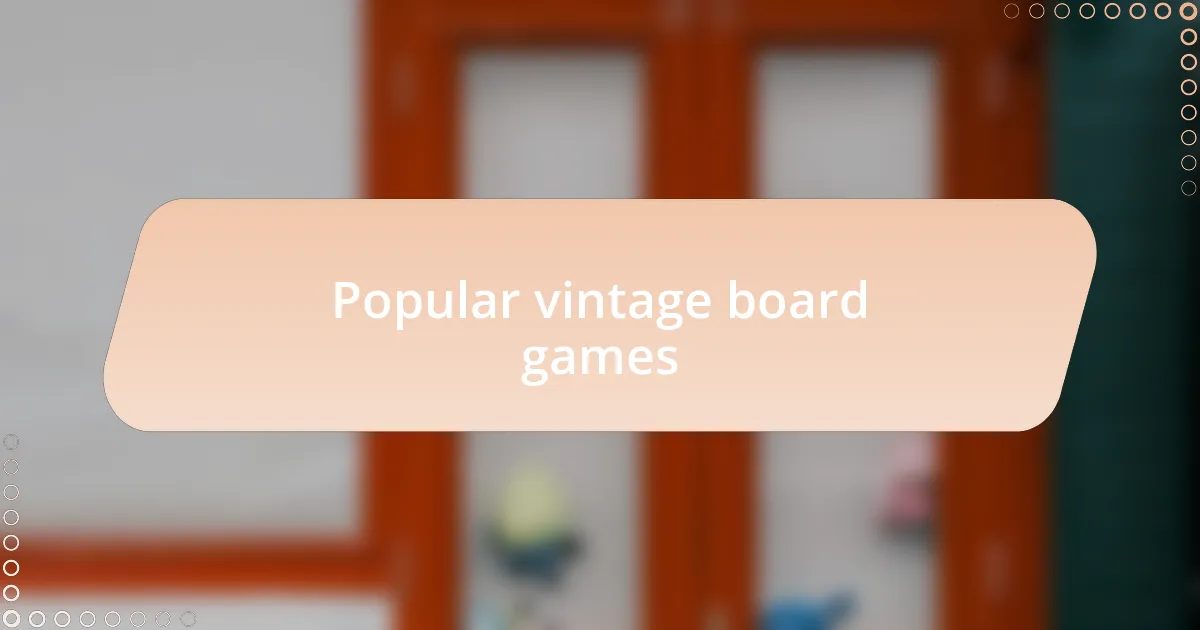
Popular vintage board games
When it comes to vintage board games, Monopoly often stands as an iconic favorite. I remember the first time my friends and I sat down to play the classic version from the 1970s; the vibrant artwork and the distinct scent of the game pieces transported me back in time. Isn’t it fascinating how a simple game can evoke such nostalgia, making you feel like you’ve stepped into a different era?
Another beloved title is Clue, the murder mystery game that sparked countless imaginative evenings for me and my siblings. I can still picture the thrill of exploring the mansion while trying to piece together who did it with what weapon, all while savoring the playful banter. Have you ever wondered how such a game can blend strategy with storytelling, creating memories that stay with us for a lifetime?
Then there’s Risk, a game that taught me the art of strategy and patience as I plotted to conquer territories across the globe. I’ll never forget those heated battles where alliances were formed and broken—each game felt like a real-life lesson in negotiation. It’s intriguing to think about how these vintage games not only entertain but also teach valuable life skills, isn’t it?
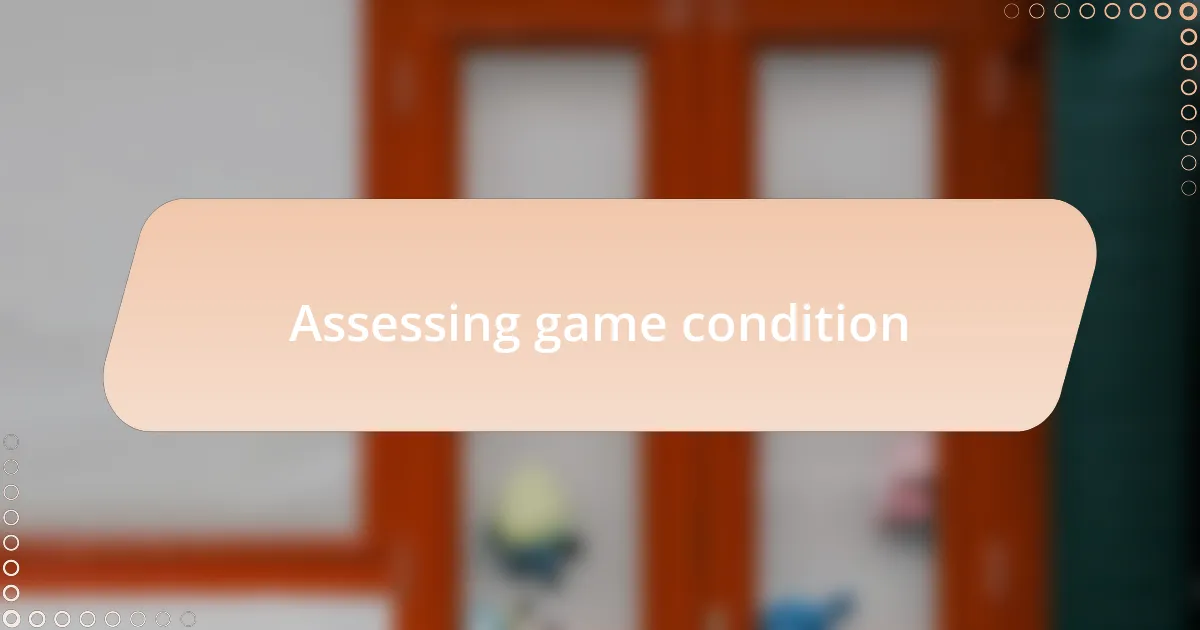
Assessing game condition
When assessing the condition of an old board game, it’s vital to start with a thorough visual inspection. I recall discovering an ancient copy of Scrabble in my parents’ attic, and at first glance, it seemed like a treasure. Yet, upon closer examination, the box was slightly warped, and I noticed a few missing tiles. This taught me that even minor imperfections can significantly impact gameplay and overall value.
Next, I like to consider the game components individually. Are the cards crisp or showing signs of wear? Does the board lie flat, or is it curling at the edges? Each detail matters. I remember a time when I found an original version of The Game of Life with almost all its pieces present. However, the spinner was stuck, which meant I couldn’t play. It reminded me just how crucial every component is; without them all functioning well, the experience is diminished.
Finally, I always pay special attention to the box itself, as it often tells the game’s history. A well-preserved box can stir emotions just by its appearance, while a battered one might evoke curiosity about its past adventures. I often think about the stories behind these games. What journeys have they been on? It’s these little insights that deepen my connection, making the act of reviving an old game feel like an exploration into the past.
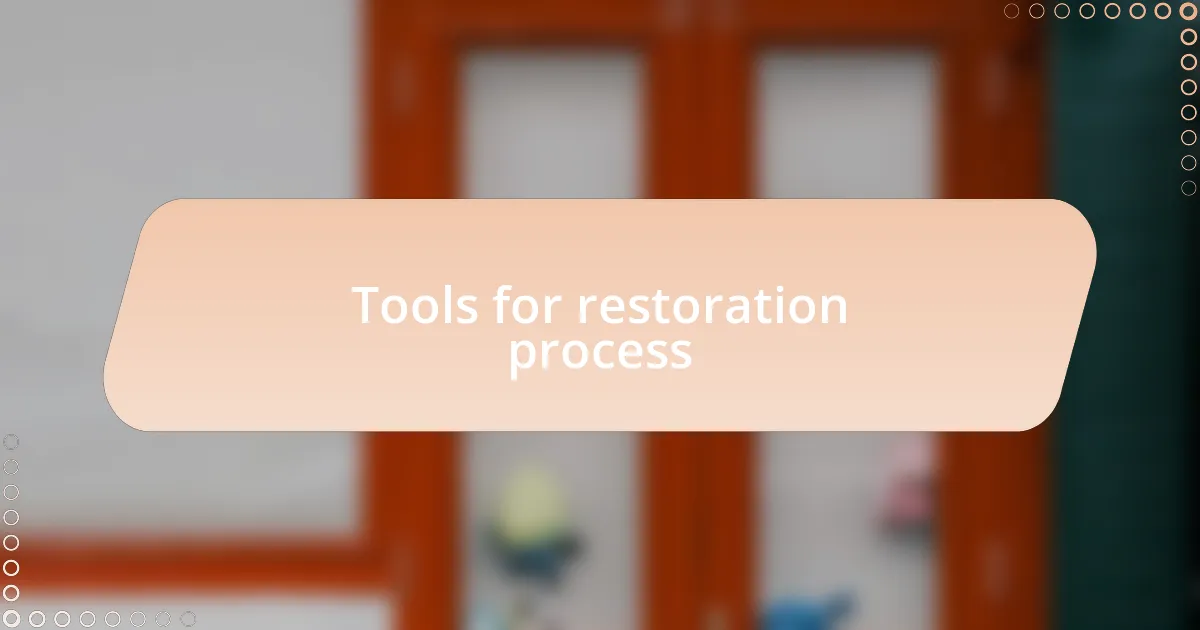
Tools for restoration process
When diving into the restoration of board games, having the right tools can make all the difference. I remember the first time I set out to restore a vintage Monopoly game; armed with nothing but a damp cloth and a sense of hope, I quickly realized I needed more. Pencil erasers became my best friends for removing stubborn scuff marks, and an adhesive glue specifically designed for paper helped revive the fragile game board.
I’ve also found that a simple set of paintbrushes offers incredible versatility for detailing and touching up game pieces. After discovering a well-loved Chutes and Ladders set with chipped colors, a few careful brush strokes of acrylic paint made it look brand new. It’s amazing how these small tools can transform a cherished relic into a vibrant piece ready for future family game nights.
Don’t underestimate the power of storage solutions, either; having a well-organized workspace can turn a daunting project into a smooth experience. I once spent hours sifting through piles of cards and pieces, frustrated by the chaos. Now, I use labeled containers to keep everything sorted; this not only saves me time but also lets me appreciate each component without the overwhelming clutter. How do you keep your restoration projects organized? Finding that balance can elevate your entire process.

Techniques for reviving components
When it comes to reviving game components, I’ve found that cleaning is often the first step that brings a game back to life. I remember tackling an old Scrabble set where the tiles were barely legible. A solution of warm water and mild soap worked wonders; I gently scrubbed each tile, and seeing them progressively regain their luster was incredibly satisfying. This moment taught me how a little elbow grease can go a long way in preserving the nostalgia of a game.
Reinforcing fragile pieces is another effective technique that I’ve utilized extensively. For example, I once had a vintage Clue game with delicate character cards that were nearly disintegrating. A light application of clear laminate helped protect them while retaining their original charm. Isn’t it fascinating how a simple intervention can save a piece of history? I often think about the stories these games hold and how my care allows them to continue being part of family gatherings.
Additionally, I’ve experimented with recreating missing components using various materials. When I found a beloved Sorry! game missing its pawns, I crafted new pieces from clay. I painted them to match the originals, and not only did they fit seamlessly into the game, but they also added a personal touch. Have you ever felt that joy of DIY creativity? It’s these little projects that truly allow us to connect with our cherished childhood games, breathing new life into them while making them uniquely ours.
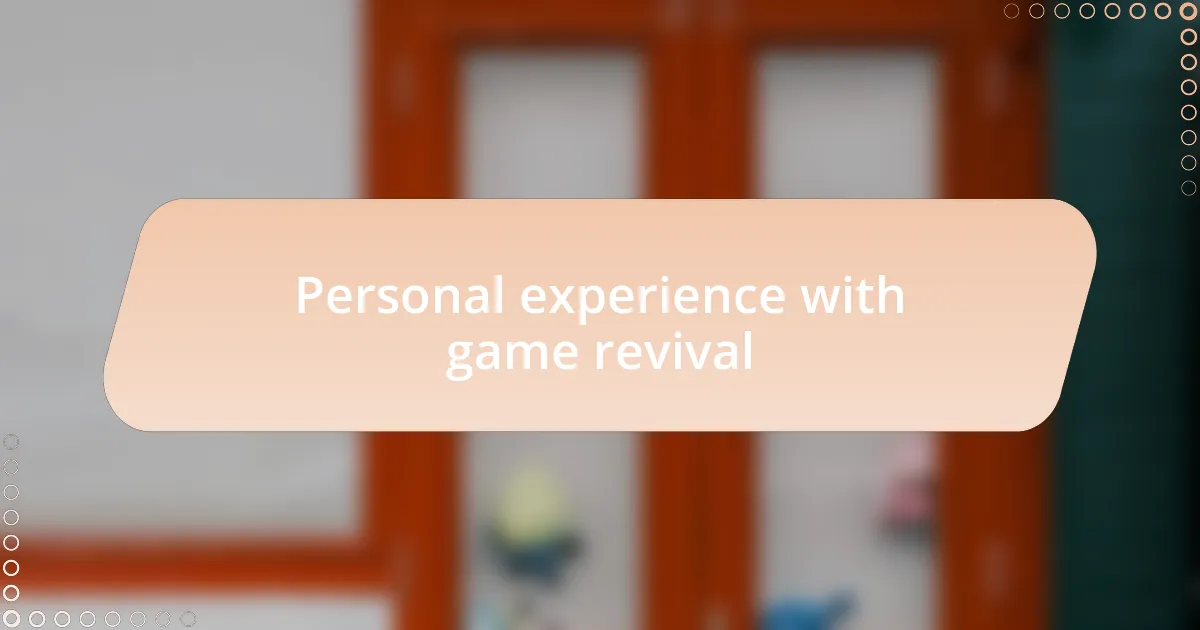
Personal experience with game revival
Reviving old board games is not just about the physical restoration; it’s also an emotional journey. I recall rediscovering a dusty box of Monopoly from my childhood in my parents’ attic. As I wiped off the cobwebs, I was hit with a wave of nostalgia—memories of family game nights flooded back. Have you ever experienced that feeling when you reconnect with a piece of your past? It’s remarkable how such a simple object can carry years of cherished moments.
Another transformative experience came when I customized the game pieces of a vintage Risk set. I had inherited it from my grandfather, and some pieces were missing or had been altered over the years. I decided to craft new tokens from stones I collected during nature walks. The process wasn’t just about replacing lost components; it became a way to honor my grandfather’s memory, each stone reminding me of our time together. Isn’t it amazing how creativity can intertwine with personal history?
Finally, I’ve found that the social aspect of game revival adds a whole new layer of enjoyment. Recently, I hosted a board game night featuring my revived versions of classic games. Watching friends marvel at their new life brought me immense joy. It made me realize that reviving these games is not just a solitary project but a way to foster connections and create new memories with others. How do you think our favorite games shape the bonds we share? For me, every game played is a new story waiting to unfold.